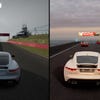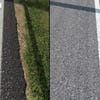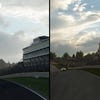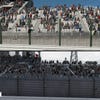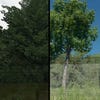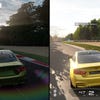Tech Analysis: Gran Turismo Sport vs Forza Motorsport 7
Vorsprung durch technik.
Forza Motorsport and Gran Turismo: two franchise juggernauts that push the technical limits of their respective platforms. As console-orientated driving simulators, they share much in common - both hand in state-of-the-art visuals, a remarkable level of fidelity, and they both target a silky-smooth 60 frames per second. With plenty of matching content in terms of cars and tracks, there are many ready-made comparison points for analysing their respective technologies. But while both Forza Motorsport 7 and Gran Turismo Sport set out with very similar objectives, the end results are often very different, underscoring a profound difference in execution - and philosophy.
Owing to Gran Turismo's traditional extended development cycle (GTS is the first Polyphony title of the generation, compared to Turn 10's third) it's rare to see Forza and GT titles release within weeks of each other, and adding further spice are the arrival of PlayStation 4 Pro and Xbox One X, upgraded consoles targeting 4K displays. We don't tend to compare platform exclusives generally, but the more we looked at these latest cutting-edge racers, the more interesting the story became. Yes, it's fascinating to see the different ways that two immensely talented developers have brought home two exceptionally good games, but at the same time, it's also a great way to appreciate the sheer craftsmanship that has gone into both.
For the purposes of our analysis, we looked at Gran Turismo Sport primarily running on PlayStation 4 Pro using its higher resolution 1800p checkerboard mode, while in the case of Forza 7, the lack of Xbox One X code made us settle on the PC version with all settings maxed out and resolution set to native 4K. Aside from improved anti-aliasing and higher refresh shadows, it's a good match for what we should expect from Microsoft's 'true 4K' console.
Before going in, a crucial point worth stressing is focus - where each developer team has placed its emphasis. Forza 7 offers a huge range of circuits and track configurations, many with variable weather conditions. The environments are richly detailed with super high-resolution textures created using photogrammetry. It also features a huge selection of richly detailed cars, the number of which vastly exceeds its rival. Gran Turismo Sport, on the other hand, focuses on a limited selection of tracks and cars but presents them in a near photo-realistic manner. Turn 10 has aimed for high quality and wealth of content, whereas we feel that Polyphony's narrower focus has led to a richer level of detail in its reduced car and track count.
The gulf in content can be vast though and shouldn't be understated. Forza 7 delivers around 700 cars, whereas GT Sport delivers 162. Beyond raw numbers, the difference is literally in the detail. We began comparisons by looking at each title's rendition of the classic Mazda MX-5 convertible. This open-top car allows us to use each game's photo mode to consider modelling quality both outside and inside the vehicle. What's apparent is that model quality on both titles borders on the insane, resolving phenomenal levels of detail that are borderline impossible to pick up on during actual gameplay.
And whereas Forza Motorsport 7 goes way beyond the call of duty, GT Sport takes things to a whole new level. Higher polygon counts on incidental detail - right down to in-cabin air vents - show Polyphony's modelling standing up better on the most close-range inspection. Physically-based lighting and material properties are also a cut-above. It's interesting to compare the two cars with identical paint schemes - Forza looks phenomenal, but a little artificial, whereas Gran Turismo's MX-5 sits more naturally within the scene. The more you compare the two titles, the more the difference in lighting makes an impact - it's clearly been an area of intense focus for Polyphony in particular.
We then compared Forza's turbo-charged Porsche GT2 RS with Gran Turismo's GT3 RS - the closest equivalent it has. Both are beautifully crafted models with smooth lines and excellent body work. Interiors look far closer here, possibly because we can only view them through the reflection-covered glass. The chances are that Polyphony built this car to the same exacting specs we saw with the MX-5, the difference being that this time we can't see the exacting attention to detail on the GT Sport model. Polyphony's lighting and materials still shine, but the gap in modelling fidelity narrows between the two titles.
And this leads to a fascinating question: Polyphony's extreme standards see its models stand up to the most insane level of scrutiny in a way that Forza's models can't quite match. But at the same time, Turn 10 is able to deliver far more cars, making for a release with considerably more content. It's perfectly legitimate to ask which approach is better for the gamer: Polyphony's quest for absolute precision must surely be a key reason why it's so far behind Forza 7 in terms of the sheer range of game content. But at the same time, respect must be given for a developer looking to push the state of the visual arts, and this exacting focus has more impact elsewhere within the game.
Moving onto tracks and environments, the same divide in philosophy remains. Forza features a blend of all types of race tracks with green fields and tyre walls contrasted against more impressive environments like Prague and Switzerland, many of which have varied weather conditions. The game features a large number of tracks overall with PC and Xbox One X boasting ultra-high resolution textures, taking advantage of the extra memory that PlayStation 4 Pro simply does not have. For its part, GT Sport features a smaller selection of tracks (which do include rallying, not present in Forza) but again, there's a strong argument that it has the edge in terms of fine detail - not to mention exquisite lighting.
Bearing in mind the relatively tiny 16.7ms time-slice available to render each frame on both games, it's remarkable how much detail both developers manage to deliver, but there are clear differences in strategy and implementation. Forza presents a more stable image overall but Gran Turismo is more ambitious with some of its choices. The additional effort can pay off but at the same time, it can more easily highlight weaknesses in the presentation.
Curiously, Forza 7 appears faster than GT Sport in motion, but this is down a slightly different focal length and the use of a subtle motion blur effect, both of which accentuate speed in the Turn 10 title. When driving, the two games line-up almost identically when racing on a laser-scanned track like the Nurburgring, as you would expect from two titles striving for realism. Beyond that, the differences are fascinating. For starters, there are the textures. Both games offer a good variety of highly detailed art but Forza has the advantage in terms of texture resolution of the track. While racing, this is difficult to notice, but it stands out when looking closely. Comparing a track like Brands Hatch, the initial reaction is that they do look very similar with slight variations in object placement around the track. General detail level though? It's very close.
Various systems do see more variation though - crowds, for starters. Up close, Forza relies mostly on flat, 2D textures scattered throughout the stands with an occasional flag waving polygonal person. In comparison, GT features a combination of simple, 3D polygonal characters mixed with a few 2D elements. The bitmapped characters in Forza jostle ever so slightly to give the impression of motion while GT's 3D crowd system features more animation and actual shadows cast by the 3D models.
Then there are the trees - this has been a point of contention between the two games as they handle these elements very differently. In Forza, trees generally consist of two flat planes or 'billboards' in a cross-pattern, fixed to the ground. While driving, this means that the trees are stationary, always facing the player like a sprite. These billboards lack any sort of realistic light interaction and do not self-shadow properly but as a result, they can appear less distracting during the race.
Polyphony Digital's approach is more ambitious. It uses flat planes which are always facing the player, but these are paired with more complex tree trunks and branches in many cases with multiple billboards, which do rotate with the camera. These trees also accept light and shadow meaning that they sit within the environment more realistically. The issue here is that during some races, the shadow position can create strange edges at a distance on top of minor pop-up. Technically, it's the more advanced approach, but it's not without its own shortcomings.
Then we come to lighting. Both games use pre-computed world lighting but for our money, the global illumination data used in Gran Turismo Sport enables more natural and realistic-looking scenes than any other racing game on the market. Low contrast lighting is especially difficult to get right but Polyphony absolutely nails it. It almost seems as if we're looking at a solution not unlike Assassin's Creed Unity - another benchmark title for pre-calculated global illumination.
This may explain why GT Sport offers multiple selectable times of day but not in-game dynamic time of day changes - each TOD selection uses different static GI data. It's an impressive solution overall, that looks particularly spectacular in HDR but that's not to say Forza 7 doesn't bring the goods. It has a very different but generally still beautiful appearance to its lighting. Some tracks, like Prague, look absolutely beautiful and highly realistic while the mountains of Switzerland feature very subtle lighting that feels spot on, suggesting that much of the difference between the two elsewhere may be found in direction rather than technology.
One element which becomes apparent once comparing the two is the difference in how shadows are implemented. With Forza 7, Turn 10 continues to utilise 'baked' - or pre-computed - shadows across its environments. All static objects use fixed shadow data while dynamic objects, such as cars, and select pieces of scenery, use real-time shadows. In comparison, Gran Turismo Sport once again seems to opt for a more ambitious solution in that all world shadows are generated and rendered in real-time.
Both implementations are equally valid and offer different strengths and weaknesses. The benefit to using baked shadows is clear - they are cheaper to render and the render quality itself can be much higher and devoid of artefacts. Static baked shadows can still give the impression of casting on dynamic objects, however, due to the way dynamic shadows are implemented across each object - they can cast a shadow and draw approximations of received shadows.
In comparison, the shadows in GT Sport often show noticeable artefacts along the shadow cascade - the further into the distance you go, the less precise the effect and the more prone it is to visible break-up. On the flipside, with Forza, storing all this baked shadow data across multiple tracks likely requires more storage space possibly increasing the size of the game. GT Sport, however, features many more unique, selectable times of day, but each time of day sees shadow positions adjusted to the sun via the real-time system while Forza's shadows are limited by the baking process.
So, basically, Forza 7's solution likely requires more storage space, limits the potential position of the sun and doesn't apply equally to all objects. Gran Turismo Sport, on the other hand, exhibits more artefacts and breakup but shadows can be modified based on the position of the sun without the need to store baked shadow data. Time of day changes are an interesting point of discussion then: Forza 7 offers a limited form of TOD cycling while GT Sport restricts you to times of day selected prior to beginning the race. It's curious that Turn 10's pre-calculated approach allows for TOD transitions whereas GT Sport's real-time system doesn't - a state of affairs that's even more strange bearing in mind that Gran Turismo 6 had it on PlayStation 3.
Both look great in terms of lighting but we feel that GT Sport takes pole position with an implementation that comes across as both more realistic and yet more stylistic too - a state of affairs that persists across all tracks. We're not entirely sure whether this is down to the engine's technical aspect as much as an entirely different approach to art direction at the studio level. In movie terms, it's like Polyphony Digital has hired the best director of photography in the business, tasked with making the aesthetic as beautiful as possible.
Beyond that, Turn 10 and Polyphony Digital add their own embellishments unique to their specific games. In Forza, there are more dynamic objects scattered about each track designed to enhance your racing experience, including tyre walls that react convincingly when you pile into them at speed. Crashes in general have much more visible impact in Forza, something that has never been much of a focus for Polyphony Digital. On the flipside, GT Sport has gorgeous lit particles that appear when racing at night. As you drive through the dirt, brake and tail lights appear in the particles - something absent in Forza 7. Both games, however, cast real-time shadows from headlights while racing at night which is a neat feature. Forza 7 also includes screen-space sun shafts on certain tracks, adding an extra element to the lighting as you drive head first into the sunlight.
Then there are the reflections - the two games employ very different techniques for this feature. In Forza, the game basically uses image data from a previous frame in generating reflections for the cars, which is why you can see things like the driving line reflected in the body work. On Xbox One and Xbox One X, these reflections are updated at half frame-rate, or 30fps.
With GT Sport, things are a little more complicated. The game uses a static cube map for the world - which is more demanding - but as a result, the resolution of the reflections is reduced. What's odd is that there seems to be variation in the update rate. In many instances, reflections appear to update at a full 60Hz. In other cases, it updates at 20 frames per second instead. This occurs primarily when using the cockpit view. Both solutions work well enough in the end but each has its compromises - for example, the player's exterior bodywork shadows in GT Sport are used on all vehicles, regardless of where they are in world space, producing some odd anomalies.
The resolution difference should be addressed as well. While we used PC primarily for our testing, Xbox One X essentially offers the same experience and renders out at full 3840x2160. By comparison, GT Sport operates at 1800p using checkboard rendering. Image quality is still good, all things considered, but it's clear that Forza 7 has a huge advantage in terms of raw image quality... at least during gameplay. One aspect of Gran Turismo that we cannot fail to mention are the replays.
For our money, GT Sport features the best replay angles and effects in any racing game ever made. Yes, it sounds hyperbolic but the camera work, motion blur quality and depth of field combine to create highly impressive results. Replays in Gran Turismo are top notch: this has always been the case with the series but the PS3 installments fell somewhat short with frame-rate issues and lower quality post-processing. Forza 7 still impresses but the angle choices and lower quality motion blur aren't quite on par. It's true that in the grand scheme of things, replays are not the most important element in a racing game but it is nice to share and save them when you have a great race. PS4 Pro can also play these back at 60fps in 1080p mode too, which takes the presentation to the next level.
Ultimately, whether you're into Gran Turismo or Forza, both games are gorgeous and represent top teams working at peak levels to deliver beautiful, high frame-rate racing games for both consoles (and an exceptional PC version of Forza is the icing on the cake). Each one has its own advantages over the other in terms of visual quality but it's fair to say that neither one is short of gorgeous. However, our analysis has demonstrated a clear divide in philosophy: Turn 10 delivers a new game without fail every two years, iterating and improving upon previous work, adding new content and features. Everything is built to exacting render budgets to ensure the series' signature, rock-solid 60fps action.
Performance-wise, GT Sport has exhibited frame-rate issues through all preview and beta code we've seen - but the game has come together beautifully in final code with what must surely be a final, concerted optimisation push, resulting in the smoothest Gran Turismo experience since the PlayStation 2 generation. By contrast, we saw early Forza code running locked at its target frame-rate during our Turn 10 studio visit at the end of March - 60fps is built into the developer's DNA, it receives total attention throughout the development process.
The sense is that Polyphony Digital has spent four years building an entirely new game seemingly from scratch with a 'we'll release when it's ready' mentality towards development. There's a dedication to detail and materials here that's rather special but in some respects may come across as overkill, bearing in mind the actual in-game experience. But then there are other aspects that are crucial to the game - like Polyphony's sublime lighting, for example. It adds beauty and perhaps even soul to the undoubted quality of the simulation.
The approach and philosophy of the studios may vary, and the implementation of key features in Forza and Gran Turismo reflects very different priorities in development - but the rivalry is real, and competition drives excellence. This 2017 face-off shows both Turn 10 and Polyphony Digital handing in exceptional releases, but with so much to learn from each other's products, the next match-up should be even more fascinating.




